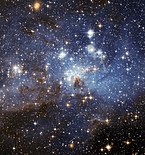Young stellar object
| Star formation |
|---|
 |
| Object classes |
| Theoretical concepts |

Young stellar object (YSO) denotes a star in its early stage of evolution.
This class consists of two groups of objects: protostars and pre–main-sequence stars.
Classification by mass
Sometimes they are divided by mass – massive YSO (MYSO), intermediate mass YSO and brown dwarfs.
Classification by spectral energy distribution
YSO are usually classified using criteria based on the slope of their SED, introduced by Lada C.J. in 1987. He proposed three classes (I, II and III), based on the values of intervals of spectral index :
.
Here is wavelength, and is flux density.
The is calculated in the wavelength interval of 2.2–20 (near- and mid- infrared region). Later Greene et al. in 1994 added a fourth class of "flat spectrum" class sources. In 1993 Andre et al. discovered class 0—objects with strong submillimeter emission, but very faint at .
- Class 0 sources – undetectable at
- Class I sources have
- Flat spectrum sources have
- Class II sources have
- Class III sources have
This classification schema roughly reflects evolutionary sequence. It is believed that most deeply embedded Class 0 sources evolve towards Class I stage dissipating their circumstellar envelopes. Eventually they become optically visible on the stellar birthline as pre–main sequence stars.
Characteristics
YSO are also associated with early star evolution phenomena: jets and bipolar outflows, masers, Herbig–Haro objects, and protoplanetary disks (circumstellar disks or proplyds).
See also
References
- ^ "Light and dark". www.spacetelescope.org. Retrieved 26 August 2014.
- Lada, C. J. (1987), IAU Symposium 115: Star Forming Regions, 115, 1
- Greene, Thomas P.; Wilking, Bruce A.; Andre, Philippe; Young, Erick T.; Lada, Charles J. (1994), Further mid-infrared study of the rho Ophiuchi cloud young stellar population: Luminosities and masses of pre-main-sequence stars, The Astrophysical Journal, vol. 434, pp. 614–626
- Andre, Philippe; Ward-Thompson, Derek; Barsony, Mary (1993), Submillimeter continuum observations of Rho Ophiuchi A – The candidate protostar VLA 1623 and prestellar clumps, The Astrophysical Journal, vol. 406, pp. 122–141











